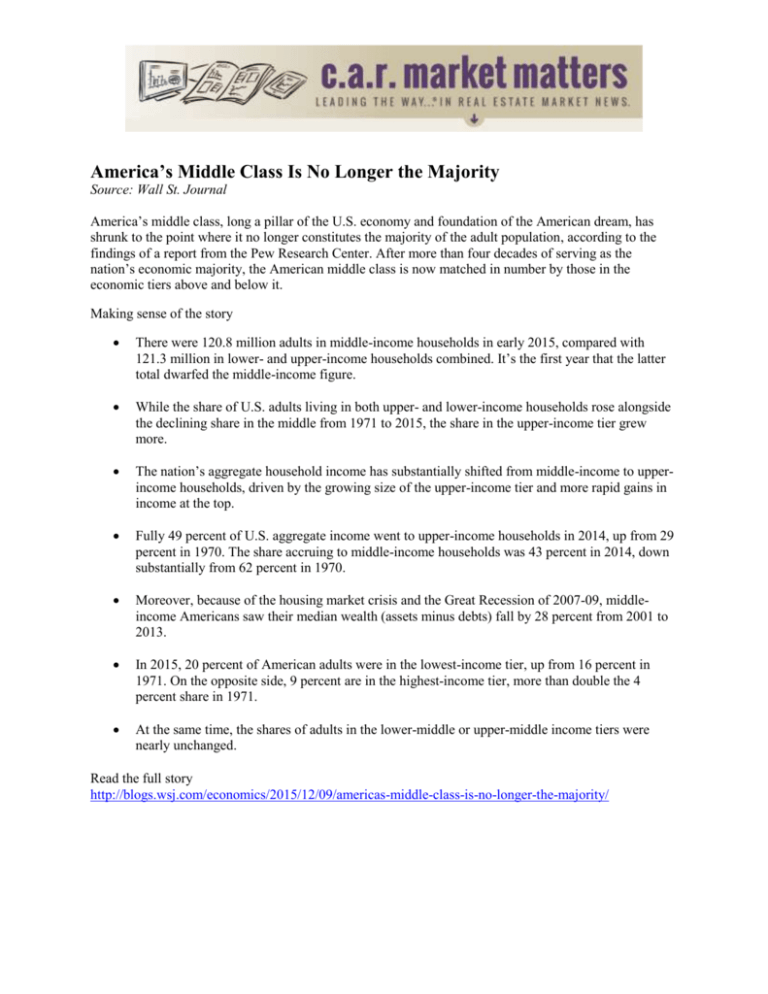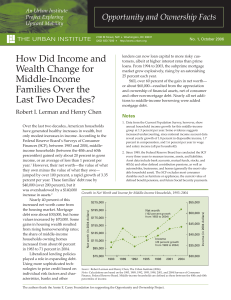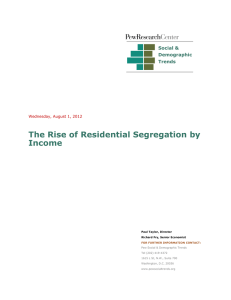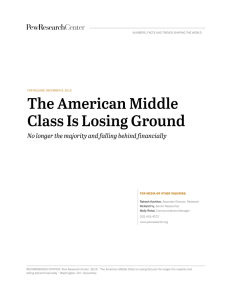America`s Middle Class Is No Longer the Majority
advertisement

America’s Middle Class Is No Longer the Majority Source: Wall St. Journal America’s middle class, long a pillar of the U.S. economy and foundation of the American dream, has shrunk to the point where it no longer constitutes the majority of the adult population, according to the findings of a report from the Pew Research Center. After more than four decades of serving as the nation’s economic majority, the American middle class is now matched in number by those in the economic tiers above and below it. Making sense of the story There were 120.8 million adults in middle-income households in early 2015, compared with 121.3 million in lower- and upper-income households combined. It’s the first year that the latter total dwarfed the middle-income figure. While the share of U.S. adults living in both upper- and lower-income households rose alongside the declining share in the middle from 1971 to 2015, the share in the upper-income tier grew more. The nation’s aggregate household income has substantially shifted from middle-income to upperincome households, driven by the growing size of the upper-income tier and more rapid gains in income at the top. Fully 49 percent of U.S. aggregate income went to upper-income households in 2014, up from 29 percent in 1970. The share accruing to middle-income households was 43 percent in 2014, down substantially from 62 percent in 1970. Moreover, because of the housing market crisis and the Great Recession of 2007-09, middleincome Americans saw their median wealth (assets minus debts) fall by 28 percent from 2001 to 2013. In 2015, 20 percent of American adults were in the lowest-income tier, up from 16 percent in 1971. On the opposite side, 9 percent are in the highest-income tier, more than double the 4 percent share in 1971. At the same time, the shares of adults in the lower-middle or upper-middle income tiers were nearly unchanged. Read the full story http://blogs.wsj.com/economics/2015/12/09/americas-middle-class-is-no-longer-the-majority/ In other news … Will El Niño hammer the housing market? Source: OC Register With the strongest El Niño on record predicted by the National Oceanic and Atmospheric Administration, all types of property owners hope to get ahead of the storms. It’s possible the storms could create construction delays, and flooding or mudslides could create some issues for local housing markets. Madeline Schnapp, director of economic research for Property Radar, commented, “If the El Niño turns out to be as bad as predicted then the potential impact of real estate sales would depend on two factors. One, location and whether or not that area is at risk for mudslides and/or flooding, and two, the month with the highest rainfall.” REALTORS® have been reminding clients that it’s always best to be prepared. Read the full story http://www.ocregister.com/articles/homes-695072-market-going.html Look Who’s Spending Less: Higher-Earning, Older Americans Source: Wall St. Journal The pace of consumer spending, outside of big-ticket items such as cars and homes, has eased, which has puzzled economists who expected improved spending in light of solid hiring, improving wage gains, and cheap gasoline. But a report from JPMorgan Chase & Co. found mid- and upper-income Americans, and those older than 65, pulled back on spending sharply from mid-2014 through June, while outlays among those younger than 35 and those with lower incomes held up fairly well. The report found overall spending on “everyday” products and services—the type of purchases you would put on your credit or debit card—rose just 0.5 percent in the second quarter of 2015, from a year earlier. Read the full story http://blogs.wsj.com/economics/2015/12/09/look-whos-spending-less-higher-earning-older-americans/ Where millennials go for financial advice Source: Yahoo! Finance In the aftermath of the Great Recession and contending with mounds of student debt, few millennials have sought out a traditional financial adviser. However, new and unconventional approaches are giving 20- and 30-somethings the financial advice they need to start saving and investing. Whether they utilize podcasts and blog posts hosted and written by financially savvy young people, or social clubs with classes and programs, millennials are still going somewhere for such information. Technology like a robo-savings tool and various apps are also popular. Financial decision-making will be important for this age group as they look to invest in the purchase of a home. Read the full story http://finance.yahoo.com/news/where-millennials-financial-advice-030300185.html Watch Ryan Gosling Break Down the Housing-Market Collapse Source: Vanity Fair The complexities of bonds, premiums, default rates, and what happened during the housing crisis of 2008 is tackled in a new movie titled “The Big Short.” Ryan Gosling’s character, Jared Vennett, uses the building block game Jenga in the movie to convince a room full of investment bankers that the housing market was guaranteed to collapse. The characters contend with making money off the crisis, and as Gosling puts it in the film, “I’m standing in front of a burning house and offering you fire insurance on it.” Read the full story http://www.vanityfair.com/hollywood/2015/12/ryan-gosling-jenga-the-big-short Chinese Cash Floods U.S. Real Estate Market Source: New York Times Chinese money has become a major force in real estate around the world. The flood of money is likely to persist despite the current tumult in China because while a currency devaluation and stock market crash have crimped the country’s buying power overseas, the resulting uncertainty is making many Chinese eager to invest anywhere except their home country. Chinese buyers have snapped up luxury condos in Manhattan and McMansions in Silicon Valley, pushing up home values in big cities. It is now spreading to the middle of the country, where prices are more modest and have room to run. In fact, Chinese families represented for the first time the largest group of overseas home buyers in the United States. A majority of home purchases by Chinese buyers — 69 percent — are entirely cash, which often outcompetes the typical American home buyer who requires a mortgage. Read the full story http://www.nytimes.com/2015/11/29/business/international/chinese-cash-floods-us-real-estatemarket.html?_r=2 Talking Points … Homebuilder confidence slipped in December, but the sector is poised for consistent growth next year. The National Association of Home Builders (NAHB) said Tuesday that sentiment in the market for newly built single-family homes fell 1 point, to 61, on the housing index. Regionally, the three-month averages showed that confidence rose 3 points in the west. The index measuring sales expectations in the next six months fell two points to 67, the component gauging current sales conditions dropped 1 point, to 66, and the index tracking buyer traffic declined 2 points, to 46.









